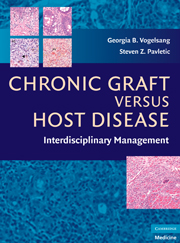Book contents
- Frontmatter
- Contents
- List of Contributors
- Preface
- PART I GENERAL PRINCIPLES
- PART II CLINICAL MANAGEMENT
- 9 Diagnosis and Staging
- 10 Chronic Graft versus Host Disease Pharmacology
- 11 Prevention of Chronic Graft versus Host Disease
- 12 Front Line Treatment of Chronic Graft versus Host Disease
- 13 Salvage Therapy in Chronic Graft versus Host Disease
- 14 Evaluating Therapeutic Response in Chronic Graft versus Host Disease
- 15 General Principles of Ancillary and Supportive Care
- PART III ORGAN SITE OR SYSTEM-SPECIFIC MANIFESTATIONS
- PART IV SPECIAL CONSIDERATIONS IN CHRONIC GVHD
- Index
- Plate section
14 - Evaluating Therapeutic Response in Chronic Graft versus Host Disease
from PART II - CLINICAL MANAGEMENT
Published online by Cambridge University Press: 26 August 2009
- Frontmatter
- Contents
- List of Contributors
- Preface
- PART I GENERAL PRINCIPLES
- PART II CLINICAL MANAGEMENT
- 9 Diagnosis and Staging
- 10 Chronic Graft versus Host Disease Pharmacology
- 11 Prevention of Chronic Graft versus Host Disease
- 12 Front Line Treatment of Chronic Graft versus Host Disease
- 13 Salvage Therapy in Chronic Graft versus Host Disease
- 14 Evaluating Therapeutic Response in Chronic Graft versus Host Disease
- 15 General Principles of Ancillary and Supportive Care
- PART III ORGAN SITE OR SYSTEM-SPECIFIC MANIFESTATIONS
- PART IV SPECIAL CONSIDERATIONS IN CHRONIC GVHD
- Index
- Plate section
Summary
INTRODUCTION
Importance of Chronic GVHD Response Criteria
Chronic graft versus host disease (GVHD) is one of the major barriers to successful outcomes in allogeneic hematopoietic stem cell transplantation (HSCT). Undoubtedly, one of the key problems has been the lack of well-designed prospective clinical trials that test agents in chronic GVHD. Accepted endpoints for chronic GVHD studies are overall survival or permanent discontinuation of immunosuppression. While these endpoints may work for a large phase III trial, they are not acceptable for early phase trials. Moreover, they are endpoints that require one to control for significant confounding variables, thus necessitating larger sample sizes typically only achievable in multisite studies. Patients, investigators, and clinicians need results from smaller early phase studies that may indicate the potential efficacy of a specific agent for treatment of chronic GVHD. Unfortunately, few such early phase trials have been conducted, and the relative absence of clinically meaningful short, intermediate, and longer-term endpoints that can be feasibly and reliably measured may deter investigators from pursuing such drug development trials (Table 14.1).
The imperative to define response criteria that are reliable, valid, and sensitive to clinically important therapeutic change is clear. Chronic GVHD problem is increasing because of the decrease in early transplant-related mortality, more frequent use of donor-lymphocyte infusions, peripheral blood stem cells, increasing age of transplant recipients, and use of more alternative donors.
- Type
- Chapter
- Information
- Chronic Graft Versus Host DiseaseInterdisciplinary Management, pp. 146 - 156Publisher: Cambridge University PressPrint publication year: 2009

